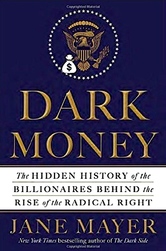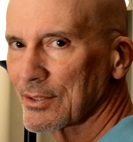A WRITER'S WIT |
My Book World

I haven’t read a more challenging book than this one in a long time—not that the 450-page tome is technically difficult to read (seventy pages are comprised of notes and an index). It is more of a textbook that could very well be studied over the course of an entire semester. Yes, it is the immensity of sickening information washing over me chapter after chapter that makes it difficult to forge ahead. I hear the author speak on C-SPAN’s Book-TV’s “In Depth” series in March (a three-hour interview), and her earnest discussion of not only this book but her entire career convinces me I should soldier through to the end. And at long last, I have.
Dark Money begins with the following caveat issued by Louis Brandeis, former Supreme Court justice, which also serves as the book’s epigraph: “We must make our choice. We may have democracy, or we may have wealth concentrated in the hands of a few, but we can’t have both.” And thus Mayer breathes life into the premise of her entire book, which she structures into three main sections: Part One, Weaponizing Philanthropy: the War of Ideas, 1970-2008; Part Two, Secret Sponsors: Covert Operations, 2009-2010; and Part Three, Privatizing Politics: Total Combat, 2011-2014. Essentially, for almost fifty years, a few individuals have attempted over and over again to exert political muscle by purchasing it. And since the SCOTUS’s Citizen’s United decision these individuals have succeeded beyond one’s wildest dreams.
In Part One, Mayer traces the lives of two of the most politically active Koch brothers, Charles and David, and how the four brothers are raised by their father, Fred Koch, to be ruthless business people. Only two manage to “succeed” to the degree that Charles and David do, but Bill and Freddie snatch their share of their inheritance and create lives for themselves apart from the family. Mayer includes the fact that the elder Fred Koch does business with the Nazis prior to World War II, helping them to build a great capacity for fuel storage. And it isn’t merely a business venture that makes him quite wealthy; Fred actually admires the fascistic elements coming to power in 1930s Europe. This fact helps to establish the ruthlessness that trickles down to Charles and David, the lengths to which either will go to get what he wants. Charles, especially, has the patience of a large feline predator, waiting, restrategizing after defeat to attack again and again until he is victor. Part One also details others who ally themselves with the Kochs: Richard Mellon Scaife, John M. Olin, and the Bradley brothers, Lynde and Harry, how they exploit so-called philanthropy [501(c)(3)s], loopholes to accumulate vast sums of untaxed money and use it illegally for political purposes. Because of limited space, I will not summarize the contents of Parts Two and Three.
Mayer weaves together her sources and observations with the icy remove of an experienced and award-winning journalist, but she never wavers from the premise that hugely wealthy individuals are conspiring always to gain power over the lives of ordinary Americans by effecting policy changes in Congress which favor Big Business. And as I do read, I must circle her titular words “dark money” at least a dozen times as she hits home the motif chapter after chapter.
Some nuggets worth the reader’s digestion (or indigestion, as the case may be):
“Almost all of the recipients [of Bradley Prizes] had played major roles in tugging the American political debate to the right. And almost all had also been supported over the years by a tiny constellation of private foundations filled with tax-deductible gifts from a handful of wealthy reactionaries whose identities and stories very few Americans knew but whose ‘overarching purpose,’ as Joyce [Bradley] said, ‘was to use philanthropy to support a war of ideas’” (119). This might as well be Mayer’s thesis statement.
“Koch claimed there was no need for government policing [of corporations] because corporations’ concern for their reputations would cause them to self-regulate” (154). Hah!
The crux of how power corrupts Washington and turning point for the ACA: “‘The Republican leadership in Congress, [Grover Norquist] said, ‘couldn’t have done it without August, when people went out on the streets. It discouraged deal makers, like Grassley’—Republicans who might otherwise have worked constructively with Obama. Moreover, the appearance of growing public opposition to Obama affected corporate donors on K Street, the center of Washington’s lobbying industry: ‘K Street is a $3 billion weather vane,’ Norquist said. ‘When Obama was strong, the Chamber of Commerce said, “We can work with the Obama administration.” But that changed when thousands of people went into the street and “terrorized” congressmen. August is what changed it.’” (194). What this statement means is that once again we citizens must “terrorize” our Congress if we wish to reverse this situation, but how?
“In Boucher’s view, the polluters had triumphed by overturning the campaign-finance laws. ‘There was a huge change after Citizens United,’ he contends. ‘When anyone could spend any amount of money without revealing who they were, by hiding behind amorphous-named organizations, the floodgates opened. The Supreme Court made a huge mistake. There is no accountability. Zero.’” (252).
“The [carried-interest] loophole was in essence an accounting trick that enabled hedge fund and private equity managers to categorize huge portions of their income as ‘interest,’ which was taxed at the 15 percent rate then applied to long-term capital gains. This was less than half the income tax rate paid by other top-bracket wage earners. Critics called the loophole a gigantic subsidy to millionaires and billionaires at the expense of ordinary taxpayers. The Economic Policy Institute, a progressive think tank, estimated that the hedge fund loophole cost the government over $6 billion a year—the cost of providing health care to three million children. Of that total, it said, almost $2 billion a year from the tax break went to just twenty-five individuals” (255). Astounding and morally offensive.
“Later, in a round of image–repairing interviews, the Kochs would portray themselves as disinterested do-gooders and misunderstood social liberals who championed bipartisan issues such as criminal justice reform. But when put on the spot and stripped of public relations help, David Koch made his priorities clear. He regarded his self-interest and the public interest as synonymous” (272). And worse, he believes that ordinary Americans agree with him!
“The numbers regarding Koch Industries’ pollution were incontrovertible. In 2012, according to the EPA’s Toxic Release Inventory database, which documents the toxic and carcinogenic output of eight thousand American companies, Koch Industries was the number one producer of toxic waste in the United States. It generated 950 million pounds of hazardous materials that year. Of this total output, it released 56.8 million pounds into the air, water, and soil, making it the country’s fifth-largest polluter” (275).
“Contrary to predictions, the Citizens United decision hadn’t triggered a tidal wave of corporate political spending. Instead, it had empowered a few extraordinarily rich individuals with extreme and often self-serving agendas. As the nonpartisan Sunlight Foundation concluded in a postelection analysis, the superrich had become the country’s political gatekeepers. ‘One ten-thousandth’ of America’s population or ‘1% of the 1%,’ was ‘shaping the limits of acceptable discourse, one conversation at a time’” (332).
The following passage demonstrates the Far Right’s perceptions: “‘We got our clock cleaned in 2012,’ Fink began. ‘This is a long-term battle.’ The challenge, he said he had learned, was that the country was divided into three distinct parts. The first third already supported the Kochs’ conservative, libertarian vision. Another third, the liberals, whom he referred to as ‘collectivists,’ using the old John Birch Society term, were beyond the Kochs’ reach. ‘The battle for the future of the country is who can win the hearts and minds of the middle third,’ Fink said. ‘It will determine the direction of the country’” (358).
“The 100 biggest known donors in 2014 spent nearly as much money on behalf of their candidates as the 4.75 million people who contributed $200 or less. On their own, the top 100 known donors gave $323 million. And this was only the disclosed money. Once the millions of dollars is unlimited, undisclosed dark money were included, there was little doubt that an extraordinarily small and rich conservative clique had financially dominated everyone else” (371). Enough said?
NEXT TIME: New Yorker Fiction 2016


 RSS Feed
RSS Feed